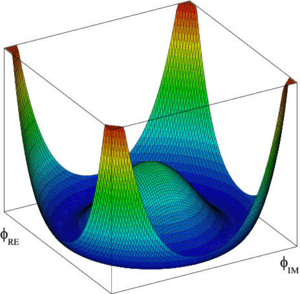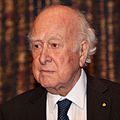Higgs field facts for kids
The Higgs field is like an invisible energy field that fills the entire universe. Think of it as a giant, sticky syrup that is everywhere. This field has a special partner: a tiny particle called the Higgs boson.
When other particles, like electrons, move through this Higgs field, they interact with the Higgs bosons. This interaction is what gives them mass. It's similar to how an object moving through thick syrup slows down and feels heavier. Particles that gain mass from the Higgs field cannot travel at the speed of light.
It's important to know that the Higgs field doesn't create mass from nothing. That would break the laws of conservation. Instead, it gives particles their mass by interacting with them. The Higgs bosons themselves carry energy, which is then transferred to the particles. Once a particle gets this "heaviness" from the field, it slows down.
If the Higgs field didn't exist, particles wouldn't have mass. They would just zoom around at the speed of light without attracting each other. This also means there would be no gravity, because gravity needs mass to work.
The process of giving mass to particles is called the Higgs effect. This effect transfers mass or energy to any particle that passes through the field. Light, for example, gains energy but not mass when it passes through, because light particles (photons) always travel at light speed.
Contents
What is the Higgs Effect?
The idea of the Higgs effect was first suggested in 1968. However, its roots go back to 1964. At that time, three different groups of scientists wrote papers. They each proposed similar but slightly different ways to explain how particles could get mass. This was important for understanding how forces work in the universe.
In 2012, scientists at the Large Hadron Collider (LHC) discovered the Higgs boson. This discovery strongly supported the idea of the Higgs effect. Finding the Higgs boson was like finding a missing puzzle piece for the Standard Model of particle physics.
According to a theory called gauge theory, all particles that carry forces should be massless. But we know that some force-carrying particles, like those involved in the weak force, actually have mass. The Higgs effect explains this. It "breaks" a certain rule, or "symmetry," called SU(2) symmetry. (SU stands for "special unitary," which is a type of mathematical matrix. The "2" refers to the size of these matrices.)
Understanding Symmetry Breaking
A symmetry in physics means that something stays the same even after you do an operation to it. Imagine a Rubik's Cube. No matter how you twist and turn it, it can always be solved. The ability to solve it is a "symmetry" of the cube. The moves you make are like operations that keep this symmetry.
But what if you take the Rubik's Cube apart and put it back together incorrectly? Now, no matter how much you twist it, you can't solve it. You've "broken" its symmetry. Taking it apart was like an "outside force." Without that outside force, the cube always stays solvable. The symmetry of the Rubik's Cube is that it remains solvable as long as you don't mess with its basic structure.
How the Higgs Boson is Created
The way the SU(2) symmetry is broken is called "spontaneous symmetry breaking."
- "Spontaneous" means it happens on its own, without an obvious push.
- "Symmetry" refers to the rules that are being changed.
- "Breaking" means these rules are no longer the same.
When this spontaneous symmetry breaking happens, it can create a Higgs boson.
Why the Higgs Effect Happens
The Higgs effect happens because nature always tries to reach the lowest possible energy state. Particles near the Higgs field want to be in their lowest energy states. To do this, at least one symmetry must be broken.
To explain how particles get mass, scientists had to think differently. They suggested that even empty space, or a "vacuum," actually has energy. So, if a particle that should be massless enters this vacuum, it gets energy from it, which gives it mass.
A mathematician named Jeffrey Goldstone showed that if you break a symmetry, something new will appear. In the case of the Higgs field, this breaking creates something called a Nambu-Goldstone boson. This is an "excited" or energetic form of the vacuum. This idea was first explained by Peter Higgs.
Images for kids
-
Nobel Prize Laureate Peter Higgs in Stockholm, December 2013





